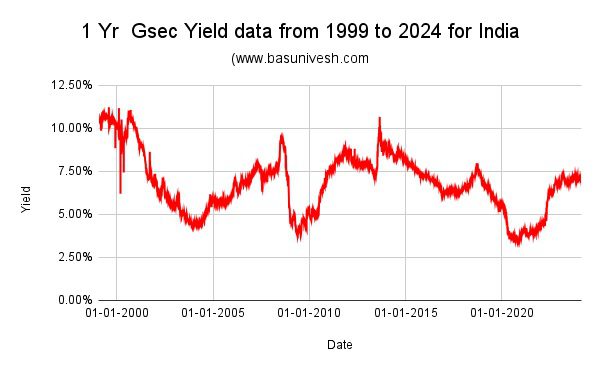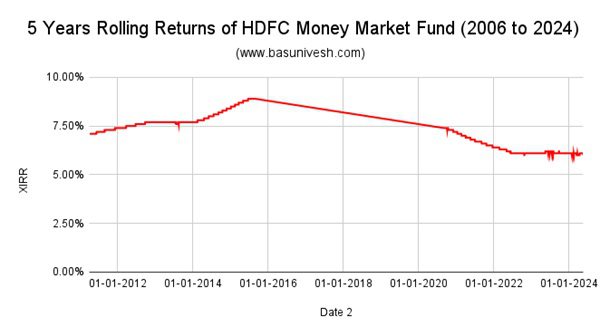Financial institution FD Vs Debt Mutual Funds – Which is SAFE and BEST? When the returns and taxation of Debt mutual Funds are nearly the identical as FD, then why Debt Mutual Funds?
That is the standard inquiry I’m more likely to encounter following current alterations within the taxation of Debt Mutual Funds. It’s broadly recognized that debt mutual funds at the moment are taxed equally to mounted deposits. Nevertheless, the important thing distinction lies within the absence of TDS in Mutual Funds (excluding NRIs). In mutual funds, taxation will come into the image if you find yourself promoting.
This text doesn’t delve into the options of Financial institution FD Vs Debt Mutual Funds. As a substitute, it focuses on inspecting the danger and volatility current in each merchandise.
I’m analyzing the 1-year Gsec information spanning the previous 25 years, in addition to the HDFC Cash Market Fund information from the final 18 years (2006 to current) for this analysis.
The explanation for having such a restricted quantity of knowledge is as a result of availability of solely 25 years of Gsec information (obtained from Investing.com) and the NAV information of HDFC Cash Market Fund ranging from 2006.
Word – To know extra about fundamentals of debt mutual funds, consult with our all earliest posts at “Debt Mutual Funds Fundamentals“.
Financial institution FD Vs Debt Mutual Funds – Which is SAFE and BEST?
Allow us to attempt to look into the danger and volatility concerned in each merchandise.
Financial institution FD as an funding in your long-term targets
Assuming you have an interest in investing in a Financial institution FD for a period of 1 yr, you will need to pay attention to the potential danger related to reinvestment after the maturity of the FD. Though long-term FDs are an possibility, for the aim of demonstrating volatility, I’ll deal with the one yr FD.
For this objective, I’ve thought-about the 1 yr Gsec information of final 25 years (from 1999 to 2024. You may discover the volatility simply from the under graph.

The fluctuating trajectory of the 1-year Gsec yield over the previous 25 years is price noting. This volatility may be attributed to the ever-changing cycles of inflation and rates of interest. It is very important acknowledge that mounted deposit charges are straight influenced by inflation, which consequently amplifies the danger related to reinvestment.
Choosing long-term FDs will increase the reinvestment danger as a result of uncertainty surrounding future inflation and rate of interest cycles.
FDs are designed to fulfill short-term wants. It isn’t advisable to make use of FDs for long-term monetary targets as a result of annual TDS implications and the reinvestment danger after maturity.
Debt Mutual Funds as an funding in your long-term targets
Let’s now study the volatility of debt mutual funds. As beforehand acknowledged, I’ve chosen the HDFC Cash Market Fund for evaluation as a result of its lengthy historical past and substantial AUM. Regardless of being in existence for twenty-four years, I solely have entry to NAV information from 2006 onwards. Due to this fact, my evaluation will probably be based mostly on information from 2006 onwards.
The number of the Cash Market Fund goals to show the instability that may happen even with short-term funds. It is because Cash Market Funds usually put money into cash market devices that can attain maturity inside a yr.


Discover the rolling coaster trip of 1-year rolling returns of HDFC Cash Market Fund. Allow us to now examine by contemplating the 5 years of rolling returns.


Regardless of the lower in volatility, you will need to observe that there are durations of upward and downward returns. These fluctuations may be attributed to the inflation and rate of interest cycles that occurred throughout these particular durations.
Conclusion – When deciding between Financial institution FDs and Debt Mutual Funds, the selection of which is safer and higher will depend on your particular funding targets and danger tolerance. Whereas FDs are typically seen as secure and low-risk investments, it’s essential to recollect the influence of TDS taxation and reinvestment dangers. Alternatively, with debt mutual funds, it’s simple to miss rate of interest dangers and assume they’re utterly safe. Nevertheless, it’s essential to be cautious, particularly contemplating the completely different classes of debt funds out there. For the sake of simplicity, let’s deal with cash market funds, however it’s important to acknowledge that different fund classes could pose completely different ranges of danger.
Nothing is protected on this earth. The one approach is to handle the danger. Additionally, danger is just too private. As a result of the danger I assume vital could also be negligible for you and vice versa.



